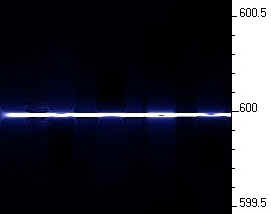iPod Clock Accuracy and Stability...
Details of frequency accuracy and stability testing of an iPod loaded with an audio file of a 600Hz audio tone.
Introduction
For a number of transmission tests there is a need to switch between various soundcard modulation modes. For example, it might be desired to run a QRSS3 segment, then a JASON segment and then a FSK31 segment. One way of implementing this is to generate a composite WAV file and run it in a loop via a PC and its soundcard output. It occurred to the author that the PC could be replaced by a simple audio device.
At first the use of a CD player was considered. Then it was realised that an iPod would be better in terms eliminating all moving parts, thereby increasing the reliability and reducing the power requirements.
The question that needed to be answered was whether the iPod D/A clock frequency was stable enough for narrowband SSB modes.
Method
An audio file of length 5 minutes was prepared in WAV format using stereo 44.1kHz sampling rate at 16-bits resolution. This is the standard format for recording to an audio CD. The file was filled with a 600Hz tone generated by functional means within GoldWave. The file was saved in WAV format (50Mbyte file size) and at the most severe mp3 compression level available in GoldWave (32 kbps - giving a file size of just over 1MByte - a 50:1 compression ratio).
These two files were then put into their own playlist within iTunes and loaded into the iPod.
The iPod was put in play mode (repeat) and the sound out of the earphone was picked up by a microphone and viewed in ARGO set to the narrowest display bandwidth available with that program - 120 second dots.
Results
The ARGO graphic crop below shows both the accuracy and the stability of the iPod audio playback rate of the uncompressed 50MByte WAV file.

The first half of the trace shows the output at room temperature (28C). ARGO was then halted and the iPod was placed in a fridge for 45 minutes at 5C. ARGO was then restarted and the audio viewed again.
The frequency at both temperatures was displayed as 599.98Hz and the traces are not separable in the 0.01Hz resolution of the ARGO 120 second dot setting.
At the end of the 5 minute file where the file is repeated the tone is interrupted for a fraction over one second. This was found to be consistent over an observed 6 cycles.
To see the effects of the 50:1 mp3 compression the two files were run back to back in repeat mode as shown in the graphic crop below.

The "cleaner" segments are the WAV file segments. The mp3 segments show a bit of "fuzz".
In practice the 512MByte iPod on hand could handle a slightly less than an hour long uncompressed WAV file. To get a 12 hour file on the iPod an mp3 compression ratio of about 13 would be required. To get 24 hours an mp3 compression ratio of about 25 would be required. One file would eliminate the gap between repeats. It all depends on whether the patience is available to build a 12 or 24 hour long file....
Conclusion
The iPod tested was found to have an accuracy and stability entirely adequate for providing tones for SSB modes for use in a MEPT. Even with mp3 compression ratios of the order of 50:1 the quality of the tone would seem to be sufficient for the narrowest bandwidth mode. Propagation path effects would be much more significant in terms of signal degradation than the effects of mp3 compression as observed.